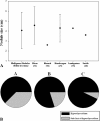A solitary hyperfunctioning thyroid nodule harboring thyroid carcinoma: review of the literature
- PMID: 23641736
- PMCID: PMC3655919
- DOI: 10.1186/1756-6614-6-7
A solitary hyperfunctioning thyroid nodule harboring thyroid carcinoma: review of the literature
Abstract
Hyperfunctioning nodules of the thyroid are thought to only rarely harbor thyroid cancer, and thus are infrequently biopsied. Here, we present the case of a patient with a hyperfunctioning thyroid nodule harboring thyroid carcinoma and, using MEDLINE literature searches, set out to determine the prevalence of and characteristics of malignant "hot" nodules as a group. Historical, biochemical and radiologic characteristics of the case subjects and their nodules were compared to those in cases of benign hyperfunctioning nodules. A literature review of surgical patients with solitary hyperfunctioning thyroid nodules managed by thyroid resection revealed an estimated 3.1% prevalence of malignancy. A separate literature search uncovered 76 cases of reported malignant hot thyroid nodules, besides the present case. Of these, 78% were female and mean age at time of diagnosis was 47 years. Mean nodule size was 4.13 ± 1.68 cm. Laboratory assessment revealed T3 elevation in 76.5%, T4 elevation in 51.9%, and subclinical hyperthyroidism in 13% of patients. Histological diagnosis was papillary thyroid carcinoma (PTC) in 57.1%, follicular thyroid carcinoma (FTC) in 36.4%, and Hurthle cell carcinoma in 7.8% of patients. Thus, hot thyroid nodules harbor a low but non-trivial rate of malignancy. Compared to individuals with benign hyperfunctioning thyroid nodules, those with malignant hyperfunctioning nodules are younger and more predominantly female. Also, FTC and Hurthle cell carcinoma are found more frequently in hot nodules than in general. We were unable to find any specific characteristics that could be used to distinguish between malignant and benign hot nodules.
Figures


Similar articles
-
Hyperfunctioning thyroid carcinoma: A systematic review.Mol Clin Oncol. 2019 Dec;11(6):535-550. doi: 10.3892/mco.2019.1927. Epub 2019 Oct 1. Mol Clin Oncol. 2019. PMID: 31798874 Free PMC article.
-
Malignancy risk of hyperfunctioning thyroid nodules compared with non-toxic nodules: systematic review and a meta-analysis.Thyroid Res. 2021 Feb 25;14(1):3. doi: 10.1186/s13044-021-00094-1. Thyroid Res. 2021. PMID: 33632297 Free PMC article.
-
[Autonomy and malignancy of thyroid glad tumors. A critical analysis of the literature on the existence of hyperfunctioning follicular and papillary thyroid gland carcinomas].Pathologe. 1996 Sep;17(5):349-57. doi: 10.1007/s002920050172. Pathologe. 1996. PMID: 8992477 Review. German.
-
Cancer risk and clinicopathological characteristics of thyroid nodules harboring thyroid-stimulating hormone receptor gene mutations.Diagn Cytopathol. 2018 May;46(5):369-377. doi: 10.1002/dc.23915. Epub 2018 Mar 8. Diagn Cytopathol. 2018. PMID: 29516685
-
Papillary thyroid carcinoma in an autonomous hyperfunctioning thyroid nodule: case report and review of the literature.Thyroid. 2010 Sep;20(9):1029-32. doi: 10.1089/thy.2010.0144. Thyroid. 2010. PMID: 20718686 Free PMC article. Review.
Cited by
-
Incidence and Risk Factors of Thyroid Malignancy in Patients with Toxic Nodular Goiter.Int J Surg Oncol. 2022 May 23;2022:1054297. doi: 10.1155/2022/1054297. eCollection 2022. Int J Surg Oncol. 2022. PMID: 35656410 Free PMC article.
-
Follicular Carcinoma Masquerading as a Hot Nodule in a Pediatric Patient.Am Surg. 2018 Jun 1;84(6):1117-1119. Am Surg. 2018. PMID: 29981658 Free PMC article.
-
Concurrent hyperthyroidism and papillary thyroid cancer: a fortuitous and ambiguous case report from a resource-poor setting.BMC Res Notes. 2016 Jul 26;9:369. doi: 10.1186/s13104-016-2178-0. BMC Res Notes. 2016. PMID: 27461263 Free PMC article.
-
Prevalence of hyperfunctioning thyroid nodules among those in need of fine needle aspiration cytology according to ATA 2015, EU-TIRADS, and ACR-TIRADS.Eur J Nucl Med Mol Imaging. 2020 Jun;47(6):1518-1526. doi: 10.1007/s00259-020-04740-y. Epub 2020 Mar 9. Eur J Nucl Med Mol Imaging. 2020. PMID: 32152666 Free PMC article.
-
Thyroid Nodules in Children and Adolescents: A Single Institution's Experience.Turk Arch Pediatr. 2023 Jul;58(4):401-406. doi: 10.5152/TurkArchPediatr.2023.22302. Turk Arch Pediatr. 2023. PMID: 37317576 Free PMC article.
References
LinkOut - more resources
Full Text Sources
Other Literature Sources

